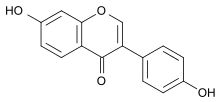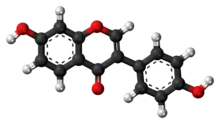Daidzein
Daidzein (7-hydroxy-3-(4-hydroxyphenyl)-4H-chromen-4-one) is a naturally occurring compound found exclusively in soybeans and other legumes and structurally belongs to a class of compounds known as isoflavones. Daidzein and other isoflavones are produced in plants through the phenylpropanoid pathway of secondary metabolism and are used as signal carriers, and defense responses to pathogenic attacks.[2] In humans, recent research has shown the viability of using daidzein in medicine for menopausal relief, osteoporosis, blood cholesterol, and lowering the risk of some hormone-related cancers, and heart disease.
 | |
 | |
| Names | |
|---|---|
| IUPAC name
7-Hydroxy-3-(4-hydroxyphenyl) chromen-4-one | |
| Other names
4',7-Dihydroxyisoflavone Daidzeol Isoaurostatin | |
| Identifiers | |
3D model (JSmol) |
|
| ChEBI | |
| ChEMBL | |
| ChemSpider | |
| ECHA InfoCard | 100.006.942 |
| KEGG | |
PubChem CID |
|
| UNII | |
CompTox Dashboard (EPA) |
|
| |
| |
| Properties | |
| C15H10O4 | |
| Molar mass | 254.23 g/mol |
| Appearance | Pale yellow prisms |
| Melting point | 315 to 323 °C (599 to 613 °F; 588 to 596 K) (decomposes) |
Except where otherwise noted, data are given for materials in their standard state (at 25 °C [77 °F], 100 kPa). | |
| Infobox references | |
Natural occurrence
Daidzein and other isoflavone compounds, such as genistein, are present in a number of plants and herbs like Kwao Krua (Pueraria mirifica) and Kudzu (Pueraria lobata). It can also be found in Maackia amurensis cell cultures.[3] Daidzein can be found in food such as soybeans and soy products like tofu and textured vegetable protein. Soy isoflavones are a group of compounds found in and isolated from the soybean. Of note, total isoflavones in soybeans are—in general—37 percent daidzein, 57 percent genistein and 6 percent glycitein, according to USDA data.[4] Soy germ contains 41.7 percent daidzein.[5]
Biosynthesis
History
The isoflavonoid pathway has long been studied because of its prevalence in a wide variety of plant species, including as pigmentation in many flowers, as well as serving as signals in plants and microbes. The isoflavone synthase (IFS) enzyme was suggested to be a P-450 oxygenase family, and this was confirmed by Shinichi Ayabe’s laboratory in 1999. IFS exists in two isoforms that can use both liquiritigenin and naringenin to give daidzein and genistein respectively.[6]
Pathway
Daidzein is an isoflavonoid derived from the shikimate pathway that forms an oxygen containing heterocycle through a cytochrome P-450-dependent enzyme that is NADPH dependent.
The biosynthesis of daidzein begins with L-phenylalanine and undergoes a general phenylpropanoid pathway where the shikimate derived aromatic ring is shifted to the adjacent carbon of the heterocycle.[7] The process begins with phenylalanine ligase (PAL) cleaving the amino group from L-Phe forming the unsaturated carboxylic acid, cinnamic acid. Cinnamic acid is then hydroxylated by membrane protein cinnamate-4-hydroxylase (C4H) to form p-coumaric acid. P-coumaric acid then acts as the starter unit which gets loaded with coenzyme A by 4-coumaroyl:CoA-ligase (4CL). The starter unit (A) then undergoes three iterations of malonyl-CoA resulting in (B), which enzymes chalcone synthase (CHS) and chalcone reductase (CHR) modify to obtain trihydroxychalcone. CHR is NADPH dependent. Chalcone isomerase (CHI) then isomerizes trihydroxychalcone to liquiritigenin, the precursor to daidzein.[6]
A radical mechanism has been proposed in order to obtain daidzein from liquiritigenin, where an iron-containing enzyme, as well as NADPH and oxygen cofactors are used by a 2-hydroxyisoflavone synthase to oxidize liquiritigenin to a radical intermediate (C). A 1,2 aryl migration follows to form (D), which is subsequently oxidized to (E). Lastly, dehydration of the hydroxy group on C2 occurs through 2-hydroxyisoflavanone dehydratase to give daidzein.[7][2]

List of daidzein-containing plants
- Pueraria lobata[9][10]
- Pueraria thomsonii[11]
References
- Merck Index, 11th Edition, 2805.
- Jung W, Yu O, Lau SMC, O’Keefe DP, Odell J, Fader G, McGonigle B. (12 November 1999) Identification and expression of isoflavone synthase, the key enzyme for biosynthesis of isoflavones in legumes. Nature Biotechnology 18:208–212.
- Isoflavonoid production by callus cultures of Maackia amurensis. S.A Fedoreyev, T.V Pokushalov, M.V Veselova, L.I Glebko, N.I Kulesh, T.I Muzarok, L.D Seletskaya, V.P Bulgakov and Yu.N Zhuravlev, Fitoterapia, 1 August 2000, Volume 71, Issue 4, pp. 365–372, doi:10.1016/S0367-326X(00)00129-5
- "Isoflavones contents of food". Top Cultures. Retrieved 15 May 2012.
- Zhang, Y.; Wang, G. J.; Song, T. T.; Murphy, P. A.; Hendrich, S. (1999). "Urinary disposition of the soybean isoflavones daidzein, genistein and glycitein differs among humans with moderate fecal isoflavone degradation activity". The Journal of Nutrition. 129 (5): 957–962. doi:10.1093/jn/129.5.957. PMID 10222386.
- Winkel-Shirley, Brenda. (1 June 2001) Flavonoid biosynthesis. A Colorful Model for Genetics, Biochemistry, Cell Biology, and Biotechnology. Plant Physiology 126:485–493.
- Dewick, Paul M. (4 February 2009). Medicinal Natural Products: A Biosynthetic Approach, 3rd Edition. Wiley Online Library: Wiley. pp 137–175. ISBN 9780470741689. Retrieved 1 June 2017.
- Prossnitz, Eric R.; Barton, Matthias (2014). "Estrogen biology: New insights into GPER function and clinical opportunities". Molecular and Cellular Endocrinology. 389 (1–2): 71–83. doi:10.1016/j.mce.2014.02.002. ISSN 0303-7207. PMC 4040308. PMID 24530924.
- Chen, G.; Zhang, J.; Ye, J. (2001). "Determination of Puerarin, Daidzein and Rutin in Pueraria lobata (Willd.) Ohwi by Capillary Electrophoresis with Electrochemical Detection". Journal of Chromatography A. 923 (1–2): 255–262. doi:10.1016/S0021-9673(01)00996-7. PMID 11510548.
- Xu, H.-N.; He, C.-H. (2007). "Extraction of Isoflavones from Stem of Pueraria lobata (Willd.) Ohwi Using n-Butanol / Water Two-Phase Solvent System and Separation of Daidzein". Separation and Purification Technology. 56 (1): 255–262. doi:10.1016/j.seppur.2007.01.027.
- Zhou, H. Y.; Wang, J. H.; Yan, F. Y. (2007). "[Separation and Determination of Puerarin, Daidzin and Daidzein in Stems and Leaves of Pueraria thomsonii by RP-HPLC]". Zhongguo Zhong Yao Za Zhi (in Chinese). 32 (10): 937–939. PMID 17655152.